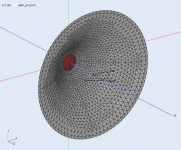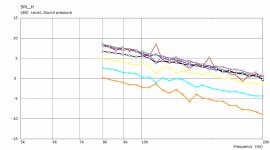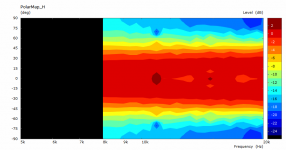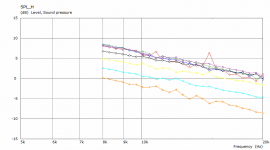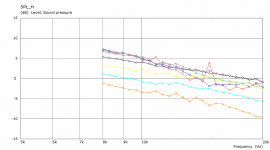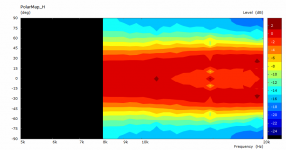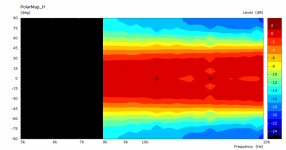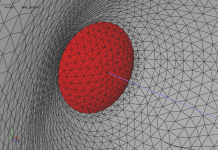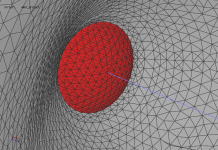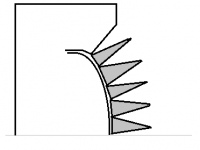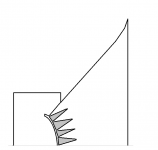I expect a dome tweeter would have a complicated wave front, especially a soft dome. That said I have modeled a waveguide using Marcel's software that used a 3/4" SB dome and the measured results were closer than I would have imagined.
Was that modelled with a flat disc as the driver? What were the differences between the modelled and measured responses?
Yes, flat disk model. Eyeballing the modeled and measured curves they looked very similar. All the same features were present.
That's the reason I intentionally didn't write it would allow simulations of dome tweeters. But it's a lot closer now as the basic shape can be set spherical, not only flat (radius being a parameter). So far I didn't bother with the surround but that may be also incorporated. In these cases the cap will be set to move axially of course.I expect a dome tweeter would have a complicated wave front, especially a soft dome. ...
What's more significant from my point is that now the real throat angle can be used in the simulations, together with a pulsating spherical cap of matching curvature as the driving element.
Last edited:
Tried the new version for the first time - a conical WG with matching spherical wavefront. A pity it's so hard to achieve in real 🙂
Match a (hypothetical) perfectly spherical wavefront of a driver with the 'desired' wavefront of the WG?
A question for Dr. Geddes:
Can you describe (some characteristics of) your 'ideal compression driver', perhaps by taking your phase plug patent into account?
Btw, how did you like Madrid?
Last edited:
Now, this may be interesting - a conical waveguide with a) spherical wavefront (on the left) and b) with an axialy vibrating dome. I just changed the source velocity vector direction, all else being the same.
Attachments
That would indicate that a hard diaphragm dome tweeter, if accurately fitted, could work pretty well in a simple conical waveguide.
I've been screaming this for years now:
HiFi tweeters work really well on waveguides.
There are situations where compression drivers are better. For instance, if you're willing to sacrifice bandwidth for efficiency.
But if your goals are modest cost and wide bandwidth, it's tough to beat a soft dome tweeter.
HiFi tweeters work really well on waveguides.
There are situations where compression drivers are better. For instance, if you're willing to sacrifice bandwidth for efficiency.
But if your goals are modest cost and wide bandwidth, it's tough to beat a soft dome tweeter.
The point here is that a conical waveguide seems better suited for a dome tweeter than an OS waveguide - I tried some, those weren't that nice, I just didn't show that. I will release the new (much updated) version soon so everyone can test whatever combination.
The spherical wavefront is a lot better IMHO. Surprised that the difference is so large.Now, this may be interesting - a conical waveguide with a) spherical wavefront (on the left) and b) with an axialy vibrating dome. I just changed the source velocity vector direction, all else being the same.
/Anton
The point here is that a conical waveguide seems better suited for a dome tweeter than an OS waveguide - I tried some, those weren't that nice, I just didn't show that. I will release the new (much updated) version soon so everyone can test whatever combination.
A well behaved compression driver produces a flat wavefront.
An aluminum dome tweeter produces a spherical wavefront at frequencies that are smaller than the diameter of the radiator. For instance, a 1" aluminum tweeter will produce a spherical wavefront above 135000Hz. (13,500Hz is one inch long.)
A soft dome tweeter is kinda awesome, because it basically operates like a ring radiator at high frequency. This is because the tip of the dome 'decouples' from the rest of the radiator.
It's hideously complex.
The reason that a conical waveguide works well with a dome tweeter is not the overall shape of the waveguide, it's the match between the throat of the waveguide and the wavefront shape of the tweeter.
For instance, an aluminum dome tweeter will produce a spherical wavefront above 13,500Hz. Because of this, a conical waveguide will perform better than a waveguide with an entrance angle of zero degrees.
Geddes has written about this extensively, none of this is my idea. Check out his patents.
Of course, you know all of this, that's why you're experimenting with plane wave tubes. Thank you for contributing so much to this. I use your software every day.
Of course it is better, but it's also unreachable 🙁 I wouldn't say it is that better, mostly an axial issue. I'm actually surprised how well the vibrating dome behaves (which is a lot more reachable in principle).The spherical wavefront is a lot better IMHO. Surprised that the difference is so large.
/Anton
BTW, would this kind of phase plug generate a reasonably spherical wavefront?
Maybe even a back side of some existing compression driver could be utilized.
Maybe even a back side of some existing compression driver could be utilized.
Attachments
Last edited:
What if we extend waveguide (negative side) down to larger diameter comp driver - check two scenarios: back side and front side firing into waveguide.
I don't get what you're aiming at. Once you get a spherical wave, it's radius should not be crucial - it's only expanding. You can do it on a 1.75" or 3" diaphragm, that shouldn't really matter (suspecting smaller diaphragms to behave better, as usual).
Last edited:
- Home
- Loudspeakers
- Multi-Way
- Acoustic Horn Design – The Easy Way (Ath4)
